
Dutch postcard, no. P. 13730. Photo: M.G.M. Cecil B. DeMille and Chief Little Bison.

American postcard by Kraus Mfg., Co., New York. Photo: Essanay. Gilbert M. Anderson (Broncho Billy). Blue eyes light, brown hat.
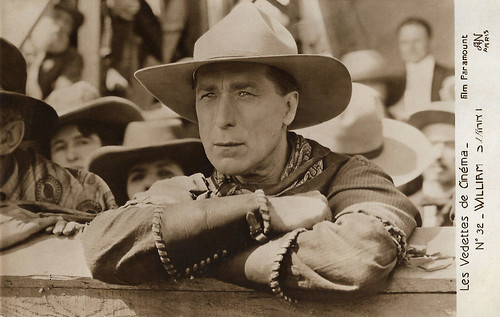
French postcard by A.N. in the Les vedettes de cinéma series, Paris, no. 32. Photo: Film Paramount. William S. Hart.

American card. Tom Mix and his horse Tony, posing.
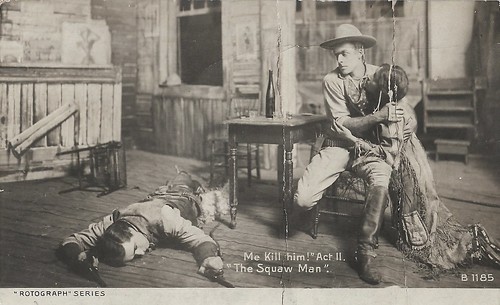
American postcard in the Rotograph series, no. B1185. Scene from the stage play version of 'The Squaw Man' by Edwin Milton Royle (1905), performed from 1905. Act II, caption: Me Kill him! (Nat-u-Ritch has killed the evil Cash Hawkins, who wanted to kill Jim Carson aka James Wynnegate). This photo is identical to the poster that was made in 1905 by the Strobridge Co. of Cincinnati for the play and that some today use as if for the 1914 film by Cecil B. DeMille. Depicted here are William Faversham as James Wynnegate, Adrienne Morrison as Nat-u-Ritch, and (just killed) William S. Hart as Cash Hawkins.

American card for the Criterion Theatre, with French handwriting. Caption: The great wagon train in "The Covered Wagon", refers to the American silent film The Covered Wagon (James Cruze, 1923).
The earliest known Western narrative film
Film Westerns derive from the Wild West shows that began in the 1870s. These shows, which included stage plays and outdoor exhibitions, culminated in Buffalo Bill's Wild West, a touring performance that ran from 1883 to 1913. Wild West shows, which were intended for urban audiences, established many of the elements that came to define Western films, such as the blending of fact and fiction and the romanticisation of the frontier. The first films that belong to the Western genre are a series of short single reel silents made in 1894 by Edison Studios at their Black Maria studio in West Orange, New Jersey. These featured veterans of Buffalo Bill's Wild West show exhibiting skills acquired by living in the Old West – they included Annie Oakley (shooting) and members of the Sioux (dancing).
The earliest known Western narrative film is not an American production but a British short Kidnapping by Indians. It was made by the Mitchell & Kenyon film company in Blackburn, England, in 1899. The plot concerns an attack by Native Americans on a camp where white people are staying. The attackers set fire to the camp and kidnap a young girl. Some cowboys arrive and a gunfight begins. The captured girl is rescued by the cowboys. The running time is 1 minute. According to Jamie Holman, a local researcher, James Kenyon of Mitchell & Kenyon met some Americans in Blackburn when he was a boy. This sparked his interest in the 'Wild West' and ultimately led to the production of this film. The storyline of a white girl being kidnapped by Indians is also in James Fenimore Cooper's novel 'The Last of the Mohicans' (1826) and many later Wild West films such as John Ford's The Searchers (1956).
Another influential early British film A Daring Daylight Burglary (1903) directed by Frank Mottershaw and produced by the Sheffield Photo Company, features members from the Sheffield Fire Brigade as part of the cast. The innovative technique of the film inspired Edwin S. Porter's film The Great Train Robbery (1903), produced by the Edison Manufacturing Company and starring Gilbert M. 'Broncho Billy' Anderson. In The Great Train Robbery, a gang of outlaws hold up and rob a steam locomotive at a station in the American West. The outlaws flee across mountainous terrain and are finally defeated by a posse of locals.
Porter's storytelling approach allowed him to include many popular techniques of the time, including scenes staged in wide shots, a matte effect, and an attempt to indicate simultaneous action across multiple scenes. Camera pans, location shooting, and moments of violent action helped give The Great Train Robbery a sense of rough-edged immediacy. A special close-up shot, which was unconnected to the story and could either begin or end the film depending on the projectionist's whim, showed Justus D. Barnes, as the outlaw leader, emptying his gun directly into the camera.
Although The Great Train Robbery was not the first Western, Porter's film set the pattern — of crime, pursuit, and retribution — for the Western film as a genre. The short film draws on many sources, including a robust existing tradition of Western films, recent European innovations in film technique, the 1896 play of the same name by Scott Marble, the popularity of train-themed films, and possibly real-life incidents involving outlaws such as Butch Cassidy. The Great Train Robbery was an unprecedented commercial success. Though it did not significantly influence or advance the Western film genre, it was widely distributed and copied.
D.W. Griffith made a series of highly successful Westerns including In Old California (1910), The Twisted Trail (1910) with Mary Pickford, The Last Drop of Water (1911), with the Western's first characteristic scenes of a wagon train siege and a cavalry rescue, the innovatively-filmed Fighting Blood (1911) about conflict between white settlers and Sioux Indians in the Dakota territory of 1899 and Griffith's last major Biograph Western filmed in Southern California, titled The Battle of Elderbush Gulch (1914).

American postcard by Detroit Publishing Co., 14180, postcard mailed US 1907. His First Lesson (1903) by the American artist Frederic Remington (1861-1909). Today, the painting is housed at the Amon Carter Museum of American Art, Fort Worth, Texas, and is part of the Amon G. Carter Collection.

American postcard by Intermountain Tourist Supply Inc., Salt Lake City, no. C9531. Natural Colors by Mike Roberts. Postcard mailed in 1962 from Cody, Wyoming. The Prospectors, now called Prospecting for Cattle Range (1889) by Frederic Remington (1861-1909), Whitney Gallery of Art, Cody, Wyoming (opened in 1959, now merged with other museums into the Buffalo Bill Center of the West in Cody). The painting was a gift by Cornelius Vanderbilt Whitney.

American postcard by Garamond / Pridemark Press, Inc., Baltimore. The Indian Bear Hunter (Henry F. Farny, 1911), Corcoran Gallery of Art, Washington DC.

American postcard. Halt, Dismount! (Frederic Remington, 1901), Timken Art Gallery, Putnam Foundation Collection.

American postcard by Garamond / Pridemark Press, Inc., Baltimore. Buffalo Trail. The Impending Storm (Albert Bierstadt, 1869), Corcoran Gallery of Art, Washington DC.

American postcard by Garamond/ Pridemark Press, Inc., Baltimore. The Last of the Buffalo (Albert Bierstadt, c. 1889), Corcoran Gallery of Art, Washington DC.
A horse named Fritz
In The Great Train Robbery (1903), Broncho Billy Anderson played the dancing tenderfoot and the train passenger who gets shot and bandit #1. Seeing the film for the first time at a vaudeville theatre and being overwhelmed by the audience's reaction, he decided to work in the film industry exclusively. He began to write, direct, and act in his own westerns under the name Gilbert M. Anderson. In 1907 in Chicago, Anderson and George Kirke Spoor founded Essanay Studios ("S and A" for Spoor and Anderson), one of the major early movie studios. In 1909, he directed the film with the first known instance of the pie-the-face gag, Mr. Flip. Anderson acted in over 300 short films. He played a wide variety of characters, but he gained enormous popularity from a series of 148 silent western shorts and was the first film cowboy star, "Broncho Billy."
So popular was the genre that Anderson soon faced competition from Tom Mix and William S. Hart. Tom Mix began his film career in 1909 as a supporting cast member with the Selig Polyscope Company. His first appearance was in a short film, The Cowboy Millionaire (1909). In 1910, he appeared as himself in a short documentary film, Ranch Life in the Great Southwest, in which he displayed his skills as a cattle wrangler. Shot in Dewey, Oklahoma with Selig studio cameramen, the film was a success, and Mix became a star. Mix performed in more than 100 films for Selig, many of which were filmed in Las Vegas, New Mexico. Fascinated by the Old West, William S. [Surrey] Hart acquired Billy the Kid's "six shooters" and was a friend of legendary lawmen Wyatt Earp and Bat Masterson. He entered films in 1914, and after playing supporting roles in two short films, he achieved stardom the same year as the lead in the feature The Bargain (Reginald Barker, 1914). Beginning in 1915, Hart starred in his own series of two-reel Western short subjects for producer Thomas Ince. Hart was particularly interested in making realistic Western films. His films, including The Disciple (1915), The Taking of Jim McLane (1915) and Devil's Double (1916), are noted for their authentic costumes and props, as well as Hart's acting ability, honed on Shakespearean theatre stages in the United States and England.
Hart's films were so popular that they were supplanted by a series of feature films, starting with The Narrow Trail (1917), Hart's first feature production for Paramount. Many of Hart's early films continued to play in theatres, under new titles, for another decade. In 1915 and 1916 exhibitors voted him the biggest money-making star in the United States. In 1917 Hart accepted a lucrative offer from Adolph Zukor to join Famous Players–Lasky, which merged into Paramount Pictures. In the films Hart began to ride a brown and white pinto he called Fritz. Fritz was the forerunner of later famous movie horses known by their own name, e.g., horses like Tom Mix's Tony, Roy Rogers's Trigger and Clayton Moore's Silver. Tumbleweeds (1925) is Hart's best-known and greatest western, by director King Baggot and from UA - about the Cherokee Strip (Oklahoma) Gold Rush; the film's title referred to a breed of roaming cowboys.
Other early cowboy stars such as Hoot Gibson, Buck Jones ("The Red Rider"), Bob Steele ("Two-Fisted Hero of the West"), Tim McCoy, Ken Maynard, Tim Holt, William Boyd (Hopalong Cassidy), George O'Brien, Bill Elliott, Charles Starrett, Johnny Mack Brown and Harry Carey contributed to a romanticised concept of the hero of Westerns. The first feature-length western was Lawrence B. McGill's six-reel Arizona (1913). The first film to feature an all-Native American cast was Hiawatha (1913), made by the Colonial Motion Picture Corporation and based on Longfellow's poem. Young Cecil B. De Mille's first motion picture was The Squaw Man (1914), usually credited as the first feature filmed entirely in Hollywood. De Mille remade the film in 1918 and 1931.
In the early days of the film industry, some real-life cowboys and legendary Western figures appeared in films: Wyatt Earp in The Half-Breed (1919) and Buffalo Bill Cody in The Adventures of Buffalo Bill (1917). Most of the hundreds of Westerns were low-budget films that had only slight variations on standard plots. But an increasing number were “big” or “epic” westerns, a type introduced in James Cruze's landmark and highly successful The Covered Wagon (1923), an expensive effort which cost $800,000 yet brought $4 million at the box office. Its success led to another silent Western tale of the building of the American empire by the construction of the Union and Central Pacific RRs - director John Ford's silent railroad classic epic The Iron Horse (1924). This type featured important stars and used larger budgets and modern production methods. The first epic Western to use talking in its soundtrack was Raoul Walsh’s The Big Trail (1930), starring John Wayne.

French postcard in the Buffalo Bill's Wild West series, no. 14. Caption: Amusements des Cowboys.

British postcard by Rotary Photographic Series, no. 4252F. Photo: Foulsham & Banfield. Publicity still for the play 'A White Man' (1908). In this play, based on the Western play 'The Squaw Man (1905) by Edwin Milton Royle, Lewis Waller appeared at the Lyric Theatre in London. In the cast, there were also several American performers, such as Herbert Sleath and George Fawcett, who already played the same parts in the 1905 play 'The Squaw Man'. Here the title is misspelled as 'The White Man'.

British postcard by Rotary Photographic Series, no. 7414 F. Photo: Foulsham & Banfield. Publicity still for the play 'A White Man' (1908). On this card, Lewis Waller as Jim Carston, Mora Lancaster as the Countess of Kerhill, Charles Allan as Malcolm Petrie, A.G, Poulton as Sir John Applegate, and Rita Leggiero as Little Hal.
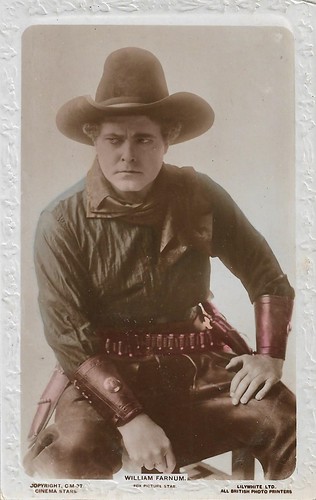
British postcard in the Cinema Stars series by Lilywhite Ltd., no. C.M. 37. Photo: Fox. American actor William Farnum (1876-1953) was one of the first major movie stars. From 1914 to 1925, Farnum was one of the biggest sensations in Hollywood, earning $10,000 a week. Farnum's silent pictures include the Westerns The Spoilers (1914) - which culminates in a spectacular saloon fistfight, and Drag Harlan (1920).

Spanish collectors card by La Novela Semanal Cinematográfica, no. 26. 'Cayena' refers to Carey's character Cheyenne Harry. American actor and cowboy Harry Carey (1878-1947) was one of silent film's earliest superstars. He was the father of Harry Carey Jr., who was also a prominent actor.
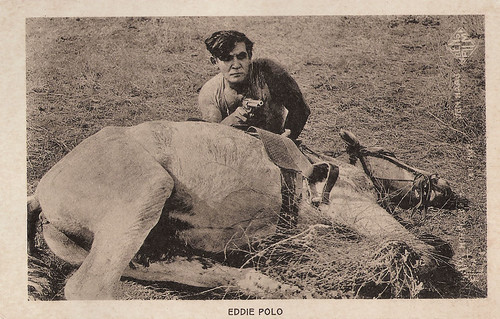
Dutch postcard by HAP Film, Den Haag. Photo: BenS Film. Eddie Polo (1875–1961) was an Austro-American actor of the silent era. With his brother Sam, he was the trapeze act The Flying Cordovas. He was the first man to parachute off the Eiffel Tower. Beginning in 1913, he appeared in serials and films in the USA and as Cyclone Smith, he became a popular Western hero. During the late 1920s, he was an action star in the German silent cinema.

American arcade card by Ex. Sup. Co., Chicago. Photo: Famous Players-Lasky. Jack Holt as Cash Hawkins, Ann Little as Nat-u-Ritch and Elliott Dexter as Jim Carson aka James Wynnegate in The Squaw Man (Cecil B. deMille, 1918), based on the eponymous play by Edwin Milton Royle.

American Arcade Card by Ex. Sup. Co., Chicago. Photo: Paramount Pictures. Thomas Meighan in The Alaskan (Herbert Brenon, 1924).

American Arcade card. Photo: Universal Production. William Desmond in The Ace of Spades (Henry MacRae, 1925). William Desmond (1878–1949) was an American actor, who appeared in 205 films between 1915 and 1948. He was nicknamed "The King of the Silent Serials" and acted in numerous Westerns.
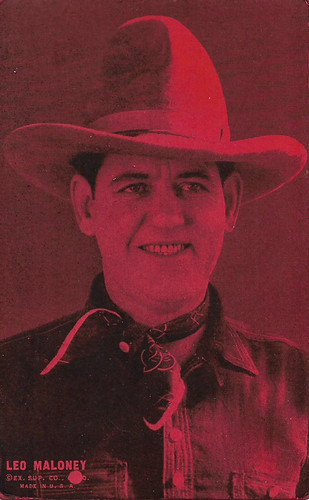
American Arcade card by Ex. Sup. Co., Chicago. Leo Maloney (1888-1929) was an American actor, stuntman, director and screenwriter. Maloney started his film career in 1911 at Selig, as a bit actor opposite Western hero Tom Mix. He appeared in 183 films,e directed forty-eight films, produced thirteen and wrote the screenplay for 10 films.

American Arcade card by Ex. Sup. Co. (Exhibition Supply Company), Chicago, Ill. Photo: Pathé. American actor Jay Wilsey (1895-1961) was a star of the silent Western and later appeared in B to Z Westerns. His first studio called him 'Buffalo Bill Jr.', although he had no connection whatsoever with the real Buffalo Bill, William F. Cody. Wilsey appeared in nearly 100 films between 1924 and 1944.
The Squaw Man
The Western has as its setting the immense plains, rugged tablelands, and mountain ranges of the portion of the United States lying west of the Mississippi River, particularly the Great Plains and the Southwest. This area was not truly opened to white settlement until after the American Civil War (1861–1865), at which time the Plains Indians were gradually subdued and deprived of most of their lands by white settlers and by the U.S. cavalry. The conflict between white pioneers and Indians forms one of the basic themes of the Western.
Another theme sprang out of the class of men known as cowboys, who were hired by ranchers to drive cattle across hundreds of miles of Western pasturelands to railheads where the animals could be shipped eastward to market. The cattle and mining industries spurred the growth of towns, and the gradual imposition of law and order that such settled communities needed was accomplished by another class of men who became staple figures in the Western, the town sheriff and the U.S. marshal. Actual historical persons in the American West have figured prominently in latter-day re-creations of the era. Wild Bill Hickok, Wyatt Earp, and other lawmen have frequently been portrayed, as have such outlaws as Billy the Kid and Jesse James.
The Squaw Man was a 1905 Western/drama stage play in four acts written by Edwin Milton Royle. It debuted on October 23, 1905, at the Wallack's Theatre, Broadway, starring William Faversham in the title role, as Captain James Wynnegate also known as Jim Carson. The doomed bad man, Cash Hawkins, was played by William S. Hart. Directed by Edwin Milton Royle and William Faversham, The Squaw Man was produced by Liebler & Company. Receiving significant critical acclaim, the play ran for 222 performances before closing on April 1, 1906. 'The Squaw' Man had four Broadway revivals, in 1907, 1908, 1911 and 1921. The 1911 revival starring Dustin Farnum ran for only eight performances. The 1921 revival starring William Faversham at the Astor Theatre ran for 50 performances. The Squaw Man was filmed three times by Cecil B. DeMille, first in 1913-14 in co-direction with Oscar Apfel. The barn which DeMille rented as his first film studio is still kept in Los Angeles. The film, starring Dustin Farnum was a huge success and confirmed the founding of the new Lasky company (out of which the major Paramount would rise). It also goes as the first American feature, even if Griffith's Judith of Bethulia was filmed first, but released after DeMille's film. DeMille made the first remake of his film in 1918, starring Elliott Dexter, after which a second followed in the early sound era (1931), starring Warner Baxter.
In literature, the Western story had its beginnings in the first adventure narratives that accompanied the opening of the West to white settlement shortly before the Civil War. Accounts of the Western plainsmen, scouts, buffalo hunters, and trappers were highly popular in the East. Perhaps the earliest and finest work in this genre was James Fenimore Cooper’s 'The Prairie' (1827), though the high artistic level of this novel was perhaps atypical regarding what followed. An early writer to capitalise on the popularity of Western adventure narratives was E.Z.C. Judson, whose pseudonym was Ned Buntline; known as “the father of the dime novel,” he wrote dozens of Western stories and was responsible for transforming Buffalo Bill into an archetype.
Owen Wister, who first saw the West while recuperating from an illness, wrote the first Western that won critical praise, 'The Virginian' (1902). Classics of the genre have been written by men who actually worked as cowboys; one of the best-loved of these was 'Bransford in Arcadia' (1914; reprinted 1917 as 'Bransford of Rainbow Range') by Eugene Manlove Rhodes, a former cowboy and government scout. Andy Adams incorporated many autobiographical incidents in his 'Log of a Cowboy' (1903). By far the best-known and one of the most prolific writers of Westerns was Zane Grey, an Ohio dentist who became famous with the classic 'Riders of the Purple Sage' (1912). In all, Grey wrote more than 80 books, many of which retained wide popularity.
Though basically an American creation, the Western had its counterparts in the gaucho literature of Argentina and in tales of the settlement of the Australian outback. The genre reached its greatest popularity in the early and middle decades of the 20th century and declined somewhat thereafter.

Austrian postcard by Iris Verlag, no. 366. Photo: Paramount-Film.

German postcard by Ross Verlag, no. 713/1, 1925-1926. Photo: Roman Freulich / Unifilman (Universal). Hoot Gibson (1892-1962) was a rodeo champion and pioneering cowboy star of silent Westerns. With his easy combination of light, breezy, boyish charm comedy and riding abilities, Hoot filled a gap between the austere William S. Hart and the flamboyant Tom Mix and appealed both to adults (especially women) and kids. During the 1920s, he was one of the most popular children's matinée heroes, ranking second only to Mix, and one of Universal's top-paid stars. In his real life, however, he had an expensive love for fast cars, motorcycles and aeroplanes and led a rather painful rags-to-riches-and-back-to-rags career.
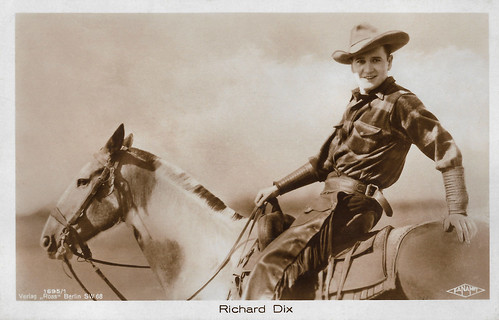
German postcard by Ross Verlag, no. 1685/1, 1927-1928. Photo: Fanamet. Richard Dix in Womanhandled (Gregory La Cava, 1925). Richard Dix (1893–1949) achieved popularity in both silent and sound film, first as the rugged and stalwart hero in countless Westerns, then dramatic features such as the Cecil B. DeMille's The Ten Commandments (1923). After his years of silent film at Paramount, and thanks to his deep voice and commanding presence, he became a well-known star at RKO in the 1930s. He was nominated for the Academy Award for Best Actor for his lead role in the Best Picture-winning epic, Cimarron (1931).

German postcard by Ross Verlag, no. 1721/1, 1927-1928. Photo: Arthur Ziehm, Berlin. William Boyd as Tom Kirby in The Last Frontier (Geoge B. Seitz, 1926).

German postcard by Ross Verlag, no. 3500/1, 1928-1929. Photo: Paramount. Handsome Fred Thomson (1890–1928) was an American silent film cowboy, who rivalled Tom Mix in popularity in the mid-1920s. He was the no. 2 box office star for 1926 and 1927 and played the legendary Jesse James and Kit Carson. In 1928, he suddenly died of tetanus, at only 38 years old.

German postcard by Ross Verlag, no. 3836/1, 1928-1929. Photo: Fox. George O'Brien (1899-1985) was a muscular, barrel-chested, yet sensitively talented leading man of classic silent films, like John Ford's The Iron Horse (1924) and F. W. Murnau's Sunrise (1927). He became a different kind of star as a cowboy in B-Westerns during the sound era.
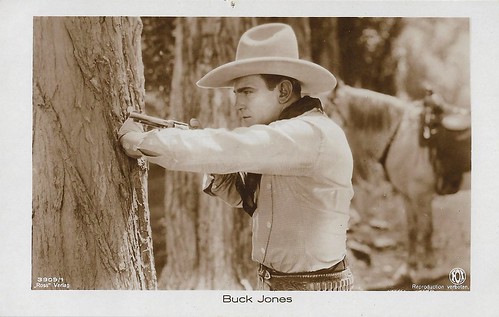
German postcard by Ross Verlag, no. 3909/1, 1928-1929. Photo: Fox. American film star Buck Jones (1891–1942) starred in many popular B-Westerns of the 1920s, 1930s, and 1940s. Executive William Fox decided to use him as a backup to Tom Mix. This led to his first starring role, The Last Straw (Denison Clift, Charles Swickard, 1920). With his famed horse Silver, Jones would make more than 160 film credits.

German postcard by Ross Verlag, no. 4813/1, 1929-1930. Photo: Radio Pictures. Tom Mix (1880-1940) was the star of many early Westerns between 1909 and 1935. Mix appeared in 291 films, all but nine of which were silent movies. He was Hollywood's first Western megastar and helped to define the genre for all cowboy actors who followed.

German postcard by Ross Verlag, no. 5826/1. Photo Universal. Ken Maynard (1895–1973) was one of the superstars among the film cowboys.
And for more silent Wild West, check out our posts Twelve Silent Cowboys and La Collectionneuse: Actresses as Native Americans.
Sources: Nanna Verhoeff (The West in Early Cinema - After the Beginning), Tim Dirks (Filmsite), Britannica, Wikipedia and IMDb.
No comments:
Post a Comment